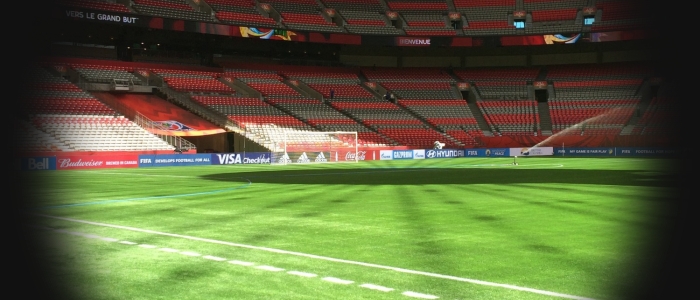World feed football commentary. What is it?
Posted on 1st December 2015

Posted on 1st December 2015
I do an awful lot of what is known as "world feed" commentaries, for clients such as HBS, UEFA and Pitch International. This blog is intended to give you an idea of the logistics of what a world feed English language commentary actually is.
When a broadcaster buys the rights to a particular competition, they may want to use their own commentators on their programme, or in the case of many English language stations around the world, they may wish to use the commentary that is supplied to them on the satellite feed of the match.
What happens is that the audio channels are split, so that the clean effects are transmitted on one part of the audio feed and commentary is supplied on another part. This enables broadcasters who are using their own commentators (whether at the stadium or working off-tube in a voiceover booth) to use the effects from the stadium and mix in with their own people's words.
If a broadcaster is taking the world feed commentary there are a number of options open to them. The simplest is that the broadcaster is showing the complete package, so their programme will begin and end with titles and they just show it as it is supplied to them, complete with the English world feed commentary.
Another option is that they may wish to present from their own studio and use the world feed commentary as if it was their own. But how do they do that when the broadcast has already started to stations who are taking more of what is on offer?
The solution is quite simple. There are a series of points in which the world feed commentator will pause, and then start again, but using different words, so that viewers who have been watching from the beginning do not feel as though the programme is constantly being re-started.
A world feed of an international match, for example, has several obvious points that broadcasters can join. I will illustrate this with some words that a world feed commentator may use at each stage.
The examples I am using to illustrate the points are an idea of what I may have said on the world feed of the Women's World Cup final in 2015. To be perfectly honest, I have no idea what I actually said! So for broadcasters who are taking the whole programme, complete with opening titles, the commentator would say something like this.
"The 2015 FIFA Women's World Cup reaches it conclusion today after a month of competition, the 52nd match of a wonderful tournament sees a repeat of the final from four years ago, as the United States of America take on the holders Japan here at BC Place in Vancouver."
Other logical points when broadcasters may join the world feed commentary are as follows.
* The point when the teams march forward from the tunnel onto the pitch. As the teams walk out the commentator says nothing, as they cross the touch line the commentator begins.
"A magnificent atmosphere at BC Place in Vancouver, as the United States of America and Japan take to the pitch in front of a sell out crowd. By far the majority of those here today will be fervently behind the USA, and willing them to lift the trophy for the first time since they did so back in 1999. But Japan won't surrender their status as world champions easily, the stage is set for a magnificent World Cup final."
* After the national anthems. This is done for example on TSN in Canada, who took the HBS world feed on the majority of matches from the 2015 Women's World Cup.
"Simply breathtaking, what an emotional rendition of the Stars and Stripes, the United States national anthem. We are in Canada, but Japan, the holders of the FIFA Women's World Cup, may well feel they are playing in the USA today."
* At kick off. The floor manager who is pitch side gives a signal that we are ten seconds from kick off, and the world feed commentator pauses, starting afresh when the match begins.
"Japan get the 2015 Women's World Cup final underway, a repeat of the final from four years ago in Frankfurt when it went to extra time and penalties before Japan defeated the USA to lift the trophy. Japan in blue, the USA in white."
There are also conventions to be followed at half time and full time. The idea is that the score graphic will be shown (usually 30 seconds) after the referee has blown for either half or full time. The world feed commentator has to finish in order to match the graphic on screen with saying the score.
When you are doing a world feed you frequently have no idea where exactly your words are being heard. It could be across entire continents, it might only be in a few countries, but whether it is a small or huge audience you have to treat the match in exactly the same professional manner.
